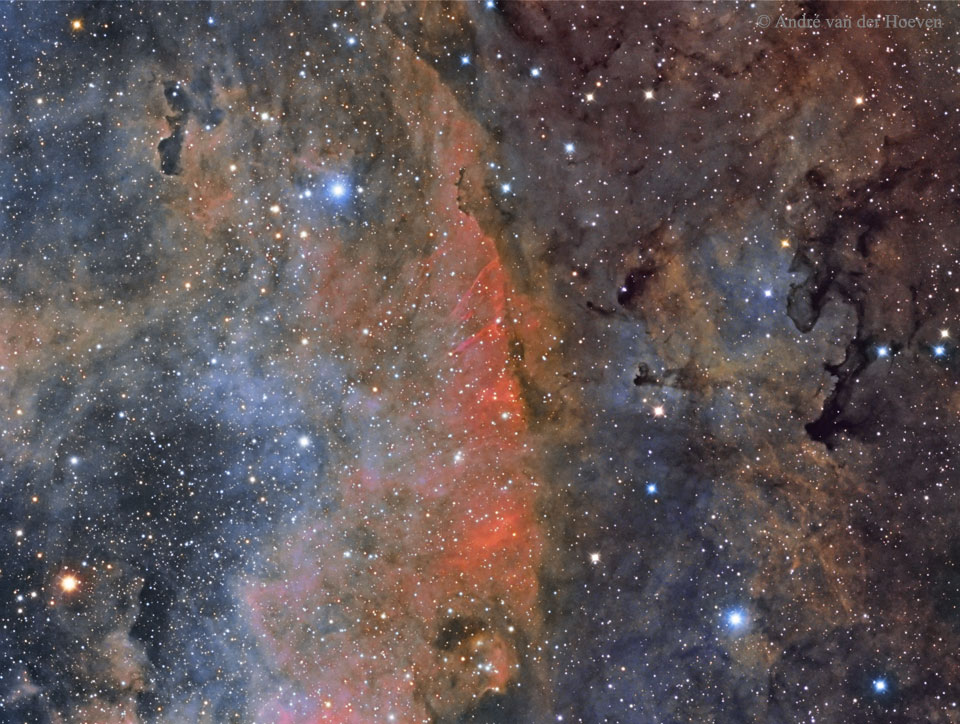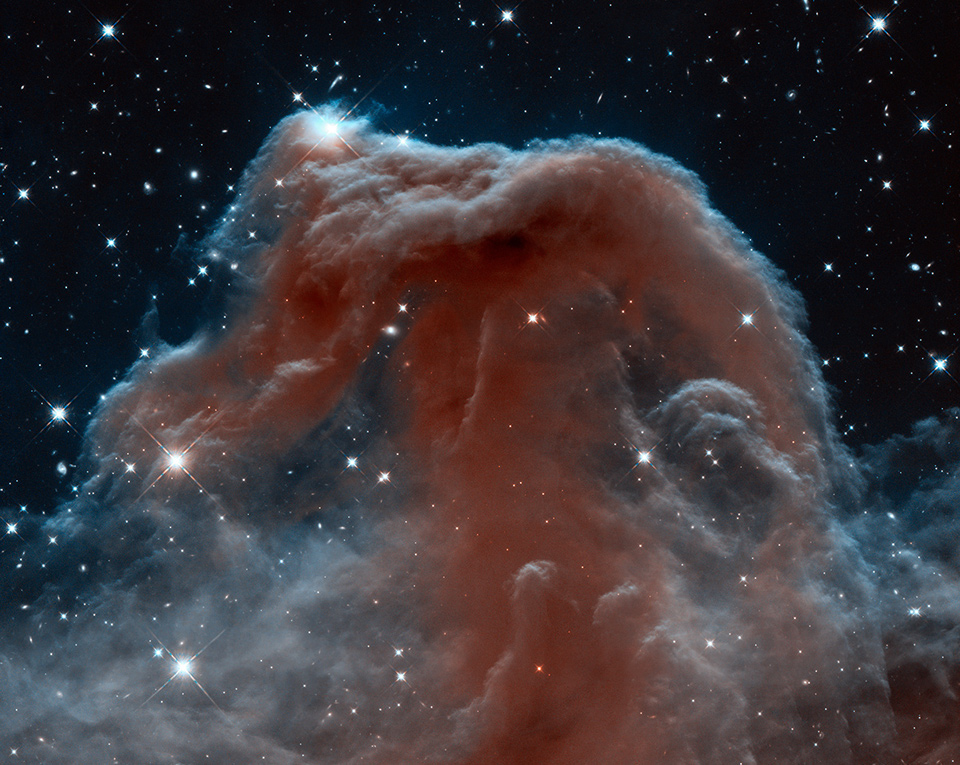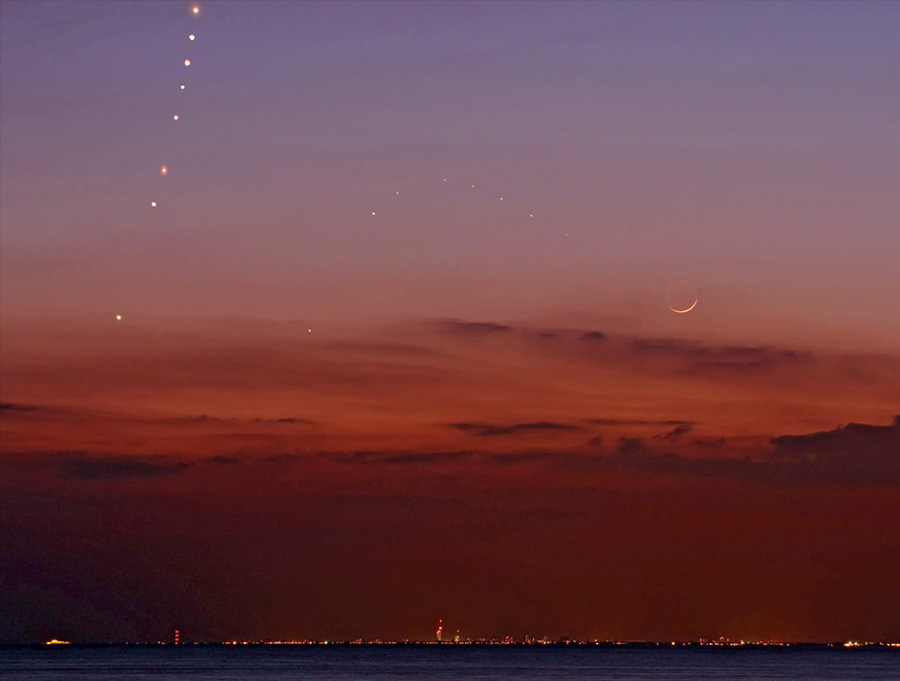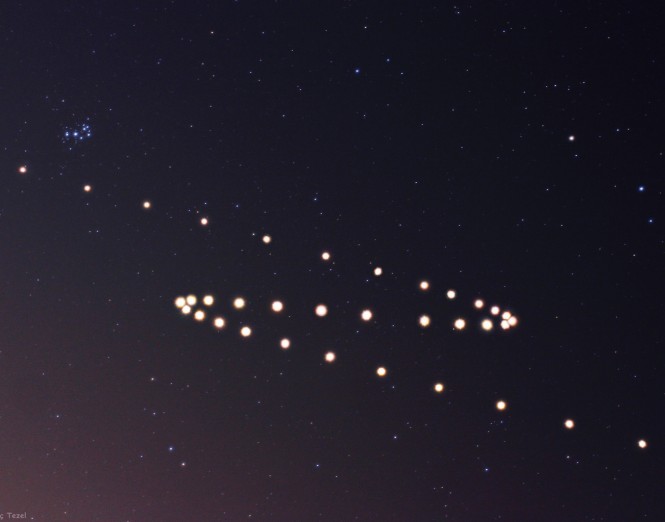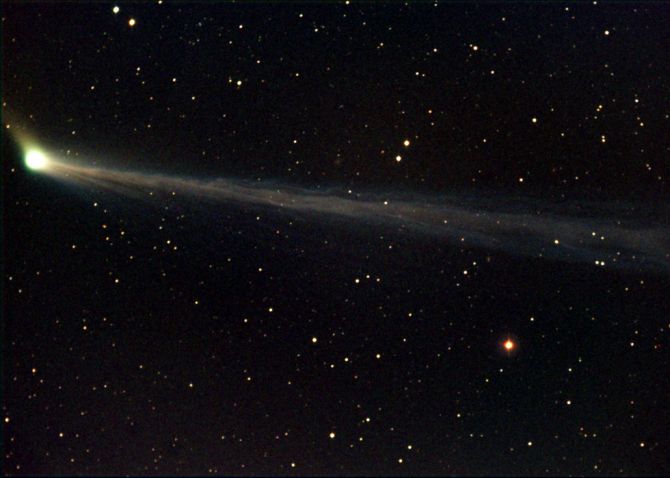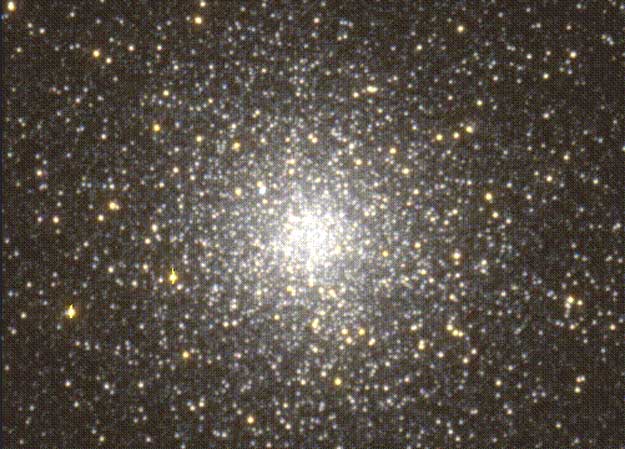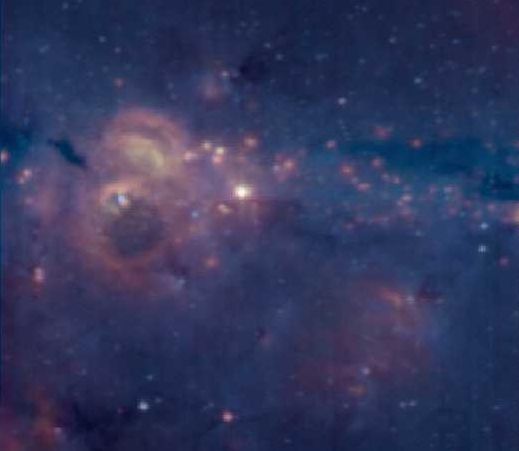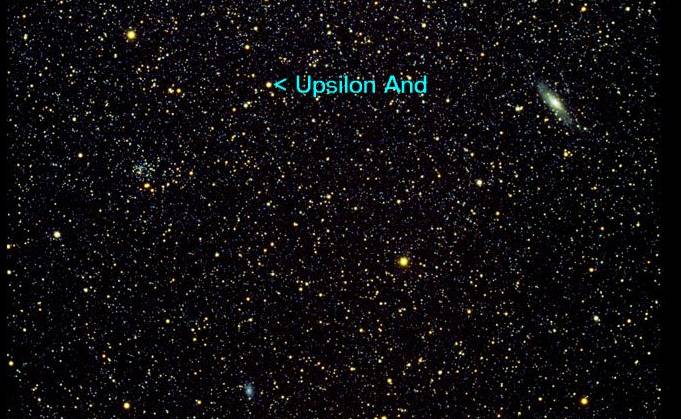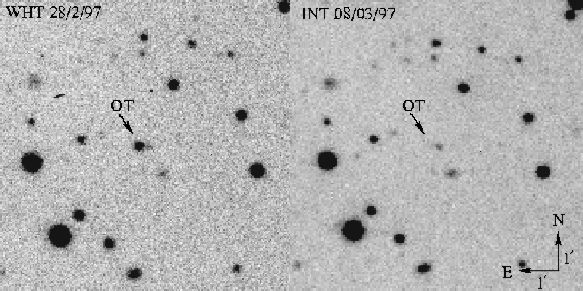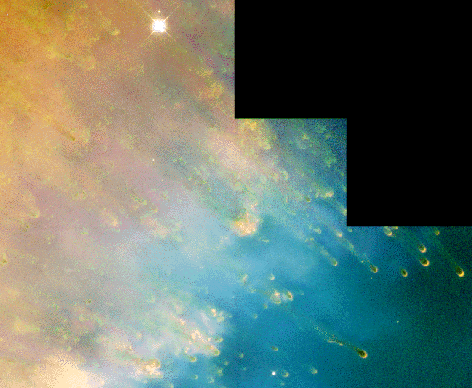| << Previous | Index | Next >> |
2015 Stars can form in colorful surroundings. Featured here is a star forming region rich in glowing gas and dark dust toward the constellation of the Swan (Cygnus), near the bright star Sadr. This region, which spans about 50 light years, is part of the Gamma Cygni nebula which lies about 1,800 light years distant. Toward the right of the image is Barnard 344, a dark and twisted dust cloud rich in cool molecular gas. A dramatic wall of dust and red-glowing hydrogen gas forms a line down the picture center. While the glowing red gas is indicative of small emission nebulas, the blue tinted areas are reflection nebulas -- starlight reflecting from usually dark dust grains. The Gamma Cygni nebula will likely not last the next billion years, as most of the bright young stars will explode, most of the dust will be destroyed, and most of the gas will drift away.
2013 While drifting through the cosmos, a magnificent interstellar dust cloud became sculpted by stellar winds and radiation to assume a recognizable shape. Fittingly named the Horsehead Nebula, it is embedded in the vast and complex Orion Nebula (M42). A potentially rewarding but difficult object to view personally with a small telescope, the above gorgeously detailed image was recently taken in infrared light by the orbiting Hubble Space Telescope in honor of the 23rd anniversary of Hubble's launch. The dark molecular cloud, roughly 1,500 light years distant, is cataloged as Barnard 33 and is seen above primarily because it is backlit by the nearby massive star Sigma Orionis. The Horsehead Nebula will slowly shift its apparent shape over the next few million years and will eventually be destroyed by the high energy starlight.
2012 When does Mars act like a liquid? Although liquids freeze and evaporate quickly into the thin atmosphere of Mars, persistent winds may make large sand dunes appear to flow and even drip like a liquid. Visible on the above image right are two flat top mesas in southern Mars when the season was changing from Spring to Summer. A light dome topped hill is also visible on the far left of the image. As winds blow from right to left, flowing sand on and around the hills leaves picturesque streaks. The dark arc-shaped droplets of fine sand are called barchans, and are the interplanetary cousins of similar Earth-based sand forms. Barchans can move intact a downwind and can even appear to pass through each other. When seasons change, winds on Mars can kick up dust and are monitored to see if they escalate into another of Mars' famous planet-scale sand storms.
2011
[imghover6=http://apod.nasa.gov/apod/image/1104/20 ... reo900.jpg]http://apod.nasa.gov/apod/image/1104/20 ... 900lab.jpg[/imghover6]Image Credit & Copyright: Rogelio Bernal Andreo
(Editor's Note: Labels courtesy of Astrometry.net)
(Editor's Note: Labels courtesy of Astrometry.net)
2010 Earlier this month, Venus and Mercury climbed into the western twilight, entertaining skygazers around planet Earth in a lovely conjunction of evening stars. Combining 8 images spanning April 4 through April 15, this composite tracks their progress through skies above Portsmouth, UK. Each individual image was captured at 19:50 UT. The sequential path for both bright planets begins low and to the left. But while Venus continues to swing away from the setting Sun, moving higher above the western horizon, Mercury first rises then falls. Its highest point is from the image taken on April 11. Of course on April 15, Venus and Mercury were joined by a young crescent Moon.
2009 As midnight approached, a spectacular sky appeared. Such was the case last month from the shore of Lake Salda in southwestern Turkey. In the above night sky panorama, rocky sand covers the foreground, while building lights are visible across the lake. Looking up, the stars of Orion lie just ahead, while Sirius, the brightest star in the sky, appears to Orion's left. To Orion's right, just above the horizon, lies the Pleiades open star cluster. Arching across the sky is the central band of our Milky Way Galaxy. High in the center, the stars Castor and Pollux are visible. Lake Salda is famous partly for its blue color that is slightly discernable even in the above image.
2008
2007 Why are parts of this asteroid's surface so smooth? No one is yet sure, but it may have to do with the dynamics of an asteroid that is a loose pile of rubble rather than a solid rock. The unusual asteroid has been visited recently by the Japanese spacecraft Hayabusa that has been documenting its unusual structure and mysterious lack of craters. Recent analyses of the border regions between smooth and rugged sections of Itokawa indicate that jostling of the asteroid might be creating segregation between large and small rocks near the surface, like the Brazil nut effect. In late 2005, Hayabusa actually touched down on one of the smooth patches, dubbed the MUSES Sea, and collected soil samples that are to be returned to Earth for analysis. Hayabusa will start its three-year long return trip to Earth this month. Computer simulations show that 500-meter asteroid Itokawa may impact the Earth within the next few million years.
2006 This composite of images spaced about a week apart - from late July 2005 (bottom right) through February 2006 (top left) - traces the retrograde motion of ruddy-colored Mars through planet Earth's night sky. On November 7th, 2005 the Red Planet was opposite the Sun in Earth's sky (at opposition). That date occurred at the center of this series with Mars near its closest and brightest. But Mars didn't actually reverse the direction of its orbit to trace out the Z-shape. Instead, the apparent backwards or retrograde motion with respect to the background stars is a reflection of the motion of the Earth itself. Retrograde motion can be seen each time Earth overtakes and laps planets orbiting farther from the Sun, the Earth moving more rapidly through its own relatively close-in orbit. The familiar Pleiades star cluster lies at the upper left.
2005 In 1905 Albert Einstein had a miraculous year. One hundred years ago, he wrote four papers which revolutionized our understanding of the Universe. The papers outlined; the idea that light could behave as a quantized particle (a photon), an explanation of the thermal motion of atoms and molecules (at a time when atoms themselves were just theories), a theory reconciling motion and the constant speed of light (Special Relativity), and the idea of mass-energy equivalence (E=mc²). Virtually every facet of our modern exploration of the Universe is touched by his now century old insights, along with his later theory of gravity and space-time - General Relativity. In centennial celebration, consider this thoughtful view of a small telescope beside the Einstein Memorial on the grounds of the National Academy of Sciences in Washington DC, USA. The marble platform at the bronze statue's feet is embedded with a map showing the positions of the planets, sun, moon and stars on the memorial's dedication date, 100 years after Einstein's birth in 1879. Albert Einstein died 50 years ago, on April 18, 1955.
2004 Discovered by the the Lincoln Near Earth Asteroid Research (LINEAR) project in October of 2002, comet C/2002 T7 is now visiting the inner solar system, making its closest approach (see animation by L. Koehn) to the Sun tomorrow, April 23rd. Emerging from the solar glare, the comet is now just visible to the unaided eye in the constellation Pisces, near the eastern horizon in morning twilight. In this gorgeous telescopic view recorded before dawn yesterday, the clearly active comet has developed an extensive, complex tail extending over 2 degrees in the anti-sunward direction, and a pronounced anti-tail or anomalous tail. Later next month this comet should appear brighter, making its closest approach to planet Earth on May 19th. In fact, it could share southern skies with another naked-eye comet, also anticipated to brighten in May, designated C/2001 Q4 (NEAT).
2003 Vast canyons, towering volcanoes, sprawling fields of ice, deep craters, and high clouds can all be seen in this image of the Solar System's fourth planet: Mars. The orbiting robot Mars Global Surveyor spacecraft took the above mosaic of images as springtime dawned in Northern Mars in 2002 May. Sprawled across the image bottom is Valles Marinaris, a canyon three times the length of Earth's Grand Canyon, and four times as deep. On the left are several volcanoes including Olympus Mons, a volcano three times higher than Earth's Mt. Everest. At the top is the North Polar Cap made of thawing water and carbon-dioxide based ice. Swirling white clouds and circular impact craters are also visible around Mars. Two rovers will be launched to Mars this summer and should arrive in 2004 January.
2002 Can you spot the comet? Flowing across the frozen Alaskan landscape is an easily visible, colorful aurora. Just to the lower left, however, well in the background, is something harder to spot: Comet Ikeya-Zhang, the brightest comet of recent years. Although the aurora faded in minutes, the comet is just now beginning to fade. It remains just barely visible without aid, however, before sunrise in the East. The comet is actually a giant dirt-covered snowball that spends most of its time in the outer Solar System -- to where it is now returns. The above photograph was taken on March 20 when Comet Ikeya-Zhang was near its brightest. Careful inspection of the photo will uncover several other sky delights, including the giant galaxy M31.
2001 Stars come in bunches. Of the over 200 globular star clusters that orbit the center of our Milky Way Galaxy, 47 Tucanae is the second brightest globular cluster (behind Omega Centauri). Known to some affectionately as 47 Tuc or NGC 104, it is only visible from the Southern Hemisphere. Light takes about 20,000 years to reach us from 47 Tuc which can be seen near the SMC in the constellation of Tucana. Red Giant stars are particularly easy to see in this picture. The dynamics of stars near the center of 47 Tuc are not well understood, particularly why there are so few binary systems there.
2000 In Jules Verne's science fiction classic A Journey to the Center of the Earth, Professor Hardwigg and his fellow explorers encounter many strange and exciting wonders. What wonders lie at the center of our Galaxy? Astronomers now know of some of the bizarre objects which exist there, like vast dust clouds, bright young stars, swirling rings of gas, and even a large black hole. Much of the Galactic Center is shielded from our view in visible light by the intervening dust and gas, but it can be explored using other forms of electromagnetic radiation. This haunting image of the Galactic Center region in infrared light was made in 1996 by a telescope onboard the Midcourse Space Experiment. The center itself appears as a bright spot near the middle of this roughly 1 degree field of view, and the north galactic pole is towards the top. The picture is in false color - starlight appears blue while dust is greenish grey, tending to red in the cooler areas.
1999 Astronomers recently announced the detection of three large planets orbiting the star Upsilon Andromedae - the first planetary system known to orbit a normal star other than our Sun. These planets were not directly photographed but found through a Doppler technique developed to use large telescopes to search nearby stars for wobbling planetary signatures. However, Upsilon And itself is visible to the unaided eye shining in Earth's sky in the northern constellation Andromeda at about 4th magnitude. This deep photographic image shows Upsilon And along with fainter stars and "deep sky" objects including the famous Andromeda spiral galaxy or M31 (right), the Triangulum galaxy or M33 (below), and the star cluster NGC 752 (left). About 44 light-years distant, Upsilon And is a star only a little more massive and just slightly hotter than the Sun.
1998 Two hundred and twenty light years from Earth, planets are forming. Recent observations of the binary star system HR 4796 have shown that one of the stars is surrounded by a dusty gaseous disk. This disk is of the right size, age, and density for dust pellets to accrete surrounding matter. A hole in the disk's center indicates that increasingly larger condensates are colliding and sticking together, coalescing into moons and planets. Pictured above is a false-color image of the system, with the bright star HR 4796A indicated by a cross. The disk measures about five times the size of our Solar System, and is seen nearly edge-on. HR 4796 is in the southern constellation Centaurus.
1997 The largest telescopes in the world have scrambled to point toward this faint, fading object. Why? Because it may well be the first active optical counterpart ever found for a gamma-ray burst, and could hold the clue to the distance scale to this most enigmatic class of astronomical objects. During the past two months, multiwavelength observations, claims, and counterclaims have been exchanged at a torrential pace, as astronomers wait impatiently to see what setting houses the fading transient. Above are two pictures of the optical transient (OT), one taken on February 28th, the other about a week later on March 8th. The OT arrows show the source that faded from view during this time. The OT has been examined by large telescopes including the Hubble Space Telescope and Keck, yet researchers are still scrambling to get answers to fundamental questions about its true nature. Does the OT actually move (exhibit proper motion)? Is there a faint galaxy superposed behind the OT or is this extended emission fading too? In the face of intense scrutiny with the world's most capable telescopes, the origin of gamma-ray bursts so far remains mysterious!
1996 While exploring the inner edge of the Helix Nebula with the Hubble Space Telescope's Wide Field Planetary Camera 2, astronomers were able to produce this striking image - rich in details of an exotic environment. This planetary nebula, created near the final phase of a sun-like star's life, is composed of tenuous shells of gas ejected by the hot central star. The atoms of gas, stripped of electrons by ultraviolet radiation from the central star, radiate light at characteristic energies allowing specific chemical elements to be identified. In this image, emission from nitrogen is represented as red, hydrogen emission as green, and oxygen as blue. The inner edge of the nebula (the direction to the central star) is toward the bottom right. Clearly visible close to the inner edge are finger shaped "cometary knots".
| << Previous | Index | Next >> |
